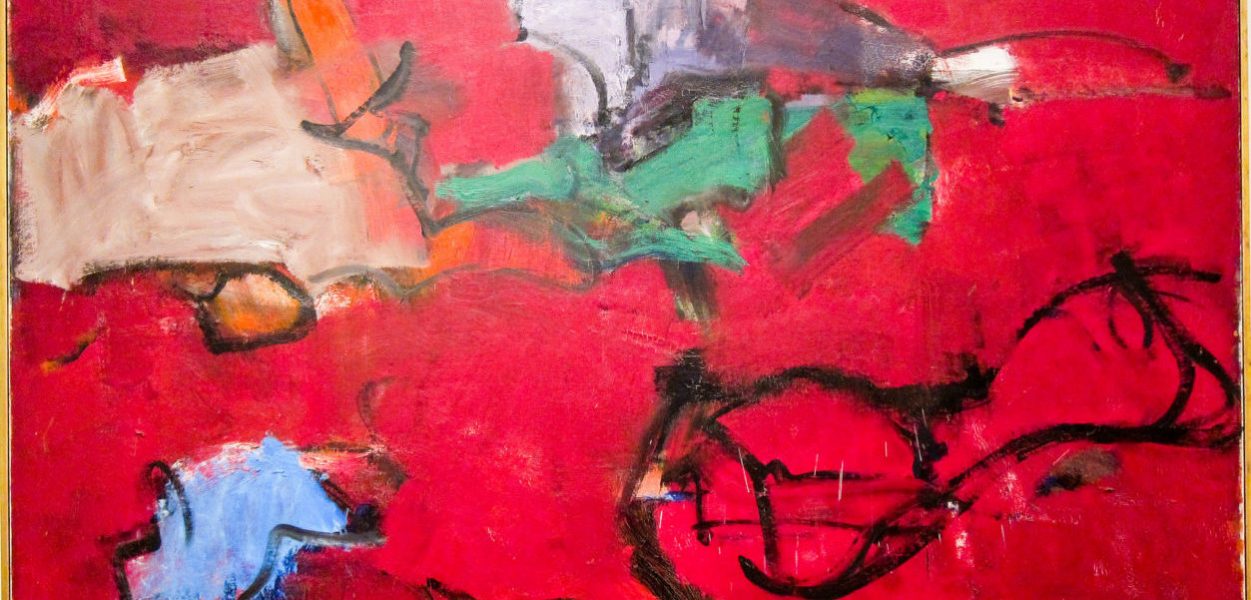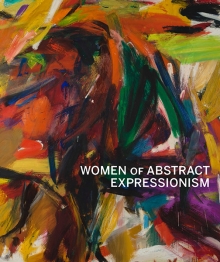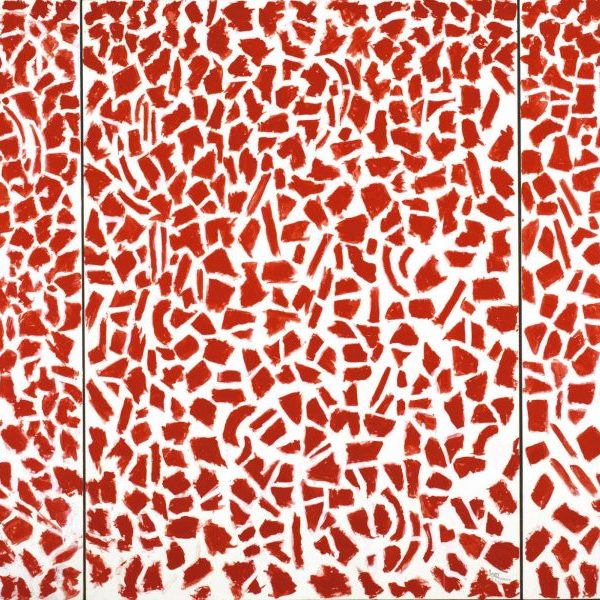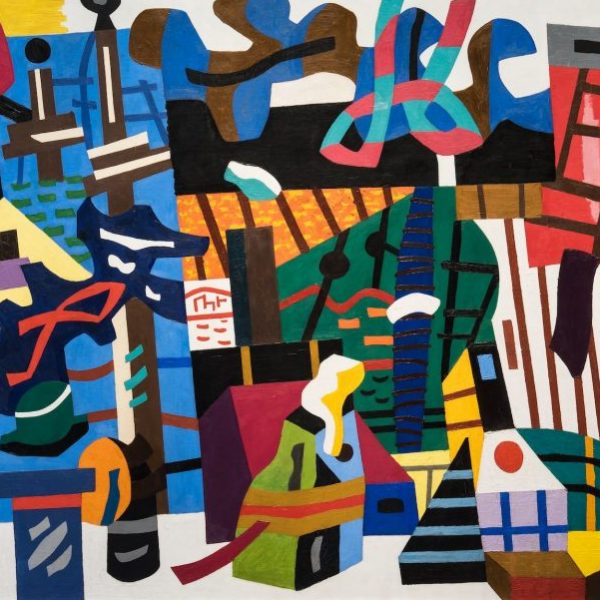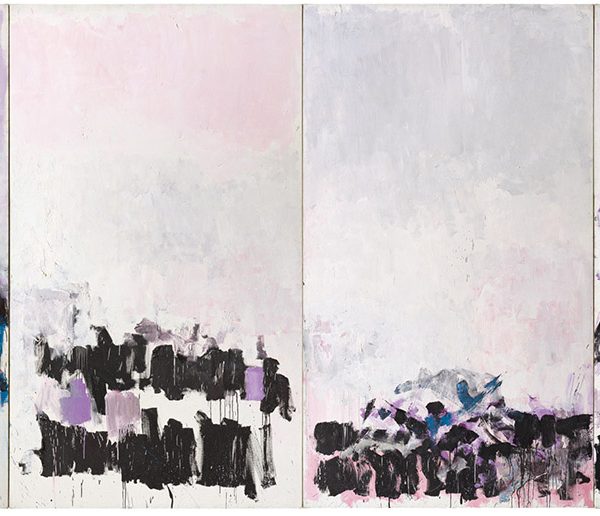Expressive Women: Interview with Gwen F. Chanzit by David Ebony
David Ebony—
When first published in an ArtNews article in 1971, the provocative question proposed by critic and art historian Linda Nochlin, “Why have there been no great women artists?” had the effect of a bombshell. Everyone in the art world realized there was a helluva lot of work to be done to properly respond to this profoundly disturbing query. For centuries, the history of Western art was indeed centered almost exclusively on the achievements of male artists, predominately white, and ostensibly heterosexual. The contributions of women, people of color, and minorities were marginalized at best, and more often totally unknown and invisible.
The answer to Nochlin’s inquiry is, of course, complex, but seems to be found in the male-dominated culture at large, and specifically within the art community itself—the individuals who write art history, direct the art institutions and galleries, the collectors, and the art press, all of which offer visibility and various platforms that allow artists to establish careers, to thrive, and above all, in the course of history, to be remembered. The male-dominated power base may not have changed much, but at least since the early 1970s, art historians, critics, museum curators, some gallerists, and collectors, have made serious attempts to be more inclusive in their efforts to rectify the situation, aiming to be more attentive to works by women and minorities.
In recent years, there have been well-received museum exhibitions devoted to female Surrealists, and women Pop artists. “Women of Abstract Expressionism,” which recently opened at the Denver Art Museum, is the most comprehensive examination to date of the role of women artists during the heyday of the Abstract Expressionist movement in the U.S., from the 1940s through the ’50s. On view in Denver through September 25, before appearances at the Mint Museum, in Charlotte, N.C., Oct. 22, 2016-Jan. 22, 2017; and the Palm Springs Art Museum, Feb. 18-May 28, 2017, the show contains more than fifty large-scale canvases by twelve artists, including several prominent figures, such as Helen Frankenthaler and Joan Mitchell, who managed to establish secure careers in the male-dominated milieu. Also included are a number of under-known artists, such as Mary Abbott, Perle Fine, Deborah Remington, Judith Godwin, and others, who deserve greater attention.
The project was co-organized by Rutgers University professor and art historian Joan Marter, who edited the accompanying catalogue, and Denver Art Museum curator Gwen F. Chanzit, who curated the exhibition. In essence, the exhibition expands upon a 1997 show, “Women and Abstract Expressionism,” which was curated by Marter. A smaller show including works by seven artists, that exhibition debuted at Baruch College, City University of New York, and traveled to the Guild Hall Museum in East Hampton. Over five years in the making, the Denver exhibition constitutes a more thorough and radical reassessment of the Abstract Expressionist movement. While Chanzit focused on the exhibition, Marter edited the show’s excellent catalogue, which contains a wealth of biographical and archival material reaching far beyond the scope of the show itself.
Via email, Joan Marter described the genesis of the project, which began to take shape in 2011. “I selected the essayists for the publication,” Marter wrote. “The decision was made to include biographies of many women who could not be included in the exhibition, but seemed to be related to Abstract Expressionism. I thank Yale University Press for a successful design of the publication. Ellen Landau, Robert Hobbs, and Susan Landauer have written excellent essays for the book.”
By all accounts, the exhibition itself is a triumph. I recently spoke about it on the phone with Judith Godwin, a featured artist in the show, whose work I have written about on a number of occasions.
“The show is so important and so overdue,” Godwin remarked, having just returned to New York after attending a preview of the exhibition in Denver. “I have great admiration for Gwen and all that she has done with this show. It was wonderful to see my work in conjunction with that of women I knew and admired, and who shared some of the same problems at the time that I did—not a whole lot of money, and little support. As women artists, we were not accepted. Unless you happened to be married to a well-known male painter, you weren’t offered a seat at the Cedar Tavern!”
Godwin did, however, gain the friendship and admiration of some powerful male painters on the scene at the time, including Franz Kline, who became a lifelong friend, and James Brooks, who finally did offer her that seat at the Cedar Tavern, as well as helped get her work shown in New York.
To gain a better understanding of how “Women of Abstract Expressionism” came to be, I recently met with Gwen Chanzit on one of her visits to New York just prior to the show’s opening.
David Ebony: What inspired the exhibition? How did it evolve?
Gwen F. Chanzit: On a short visit to New York in 2008—mainly to see Olafur Eliasson’s Waterfalls installation [June through October, 2008], I saw several major exhibitions right in a row. One of them was “Action/Abstraction” at the Jewish Museum, a wonderful show curated by Norman Kleeblatt. It was centered on the critics Harold Rosenberg and Clement Greenberg. There were a number of artists in the show I didn’t know before. On the plane on the way home I thought about what other artists of the Abstract Expressionist era might be not so well known, especially women artists.
As far as I knew, Joan Marter had done the only show on the theme of women in Abstract Expressionism, which appeared at Baruch College. I saw the women in Pop exhibition at the Brooklyn Museum in 2011 [“Seductive Subversion: Women Pop Artists, 1958-1968”]; and later, the women in Surrealism show [“In Wonderland”] at LACMA. I did not set out to do a show about women artists, but I thought it was important to show artists who had been left out of the history, and I could bring to light some of these women of the Abstract Expressionist era who did great work but hadn’t received much attention.
Ebony: What were some of the biggest surprises for you while working on the show?
Chanzit: The biggest surprise was that no one had done a large-scale show like this before. When I started gathering the works, many were hidden away in private collections or in storage, and had not seen the light of day in decades, almost since the time they were made. And a surprising number of works shown back then had been subsequently destroyed or lost.
Ebony: There seem to be many sub-plots to the story, such as the women who destroyed their output from the era, as was the case with Vita Petersen, which you mention in the catalogue.
Chanzit: We were not able to find any Vita Petersen works from the 1950s, even though she showed regularly at Tanager Gallery and elsewhere at the time. As was the case in a number of families I met with or spoke to while preparing this show, some of the artists in the group abandoned their art practice when they started families. When they became mothers, some of them trashed all of their works. I was skeptical about that at first, but then the family members would show me photos of their mother with Harold Rosenberg on a visit to her studio, for instance, or seated at the Cedar Tavern with some well-known artists of the day. Some women abandoned their painting careers for fabric design, or similar pursuits. There were many cases like this, so many that we could not include them all in the catalogue, even as a footnote.
Ebony: The biographies in the back of the catalogue, including those for many artists not in the show, reveal some amazing stories, and seem important as a resource for future research.
Chanzit: I surveyed over 100 artists when I was preparing the show. As soon as word got out that we were doing this, I started to get inundated by calls from people saying their mother or relative had been an Abstract Expressionist painter. It was a challenge getting the list down to the 41 or 42 artists profiled in the catalogue. The catalogue and the exhibition are two different things. For the exhibition, we wanted to feature only twelve artists, to show them in depth, with multiple examples. That was very difficult.
Ebony: It was probably a good idea to keep the show compact and focused.
Chanzit: As an art historian, we want to tell the world everything, the whole story. But that’s not always feasible. In this show, every one of the twelve artists has her own space in the gallery. We would like viewers to come away from the show with an understanding of each artist as an individual. Individuality in Abstract Expressionism is of great importance; one of the things I say to people is that you can teach someone how to make a Cubist painting. It might not be a good painting, but you can teach it. But you cannot teach someone how to make an Abstract Expressionist painting. They are individual responses.
Ebony: In his interview with Joan Marter for the catalogue, Irving Sandler says that the men of Abstract Expressionism wanted to be ultra-macho in order to distract from the prevailing feeling at the time that there were certain feminine associations with art and art making. I always thought, instead, that it was part of the general World War II era syndrome that women were expected to go back to their traditional domestic activities in order for men to regain control at home after the war, and to leave the more weighty chores of cultural progress to the men.
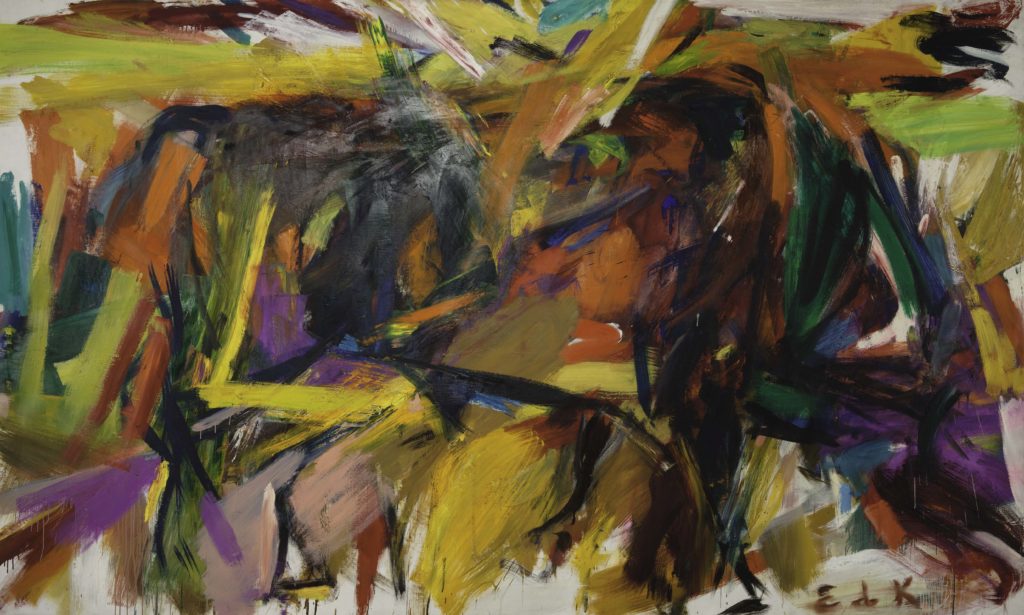
Elaine de Kooning Bullfight, 1959. Oil paint on canvas; 77 5/8 in. × 10 ft., 10 1/2 in. Denver Art Museum: Vance H. Kirkland Acquisition Fund, 2012.300. Courtesy Mark Borghi Fine Art, New York. © Elaine de Kooning Trust
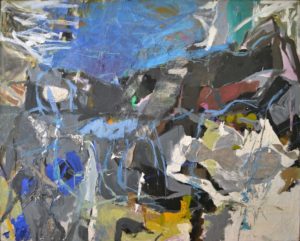
Perle Fine Summer I, 1958-59. Oil paint and collage on canvas; 57 x 70 in. Collection of Craig A. Ponzio. Image courtesy of McCormick Gallery, Chicago. © AE Artworks, LLC.
Chanzit: I think you are both right! I am careful not to say “men this, and women that,” since, as this show proves, there are many exceptions that will come up; but someone suggested to me that part of the macho thing with the Abstract Expressionist men is that they leave so many works untitled. If you look at the works in our show, you’ll see that the women give some entry into the theme of the work by means of a title; whether it references a person or an event, such as Elaine de Kooning’s Bullfight, or the seasons, as with Perle Fine’s Summer I. And then, of course, there are Judith Godwin’s references to her close friend the choreographer Martha Graham in her work. I think that there are some very special aspects like this that deserve further examination in the history of Abstract Expressionism. I recall a comment by Frankenthaler to Barbara Rose, taken out of context but appropriate to mention here, when asked why she titles her paintings, Frankenthaler said it’s because a title has to have a meaning. I think that is such an interesting remark.
Ebony: You mention that the themes of women painters were often personal responses to life experience—a response to nature, for instance, as contrasted with Pollock’s famous statement, “I am nature.”
Chanzit: The moment you set up contrasts of men versus women, you are open to examples that would defy any differentiation. But I think there are some differences to be explored, as in the titles and the meanings that the works suggest.
Ebony: A lot has changed since the 1950s, and many of these differences are not so evident now that many women artists have lately established successful careers, and some are vital figures of the avant-garde.
Chanzit: We have to remember that it was an entirely different era. Janson’s History of Art was the standard art history book used for many years as a text book since 1962, and there was not a single woman artist mentioned in it. There were almost no women included in the story of art until the 1980s.
Ebony: Why are the women painters in the exhibition considered “Second Generation” Abstract Expressionists?
Chanzit: You hit something so interesting. You’ll notice that in my introduction to the book I avoid that term. Maybe this is part of the problem. There’s a notion that the core group were men, the main characters. And this is thought of as the “First Generation,” defying the chronology, and the fact that the women artists were making related works at the same time.
Ebony: Did the term start with Joan Mitchell?
Chanzit: It may have come from Irving Sandler’s 1957 article in ArtNews, “Joan Mitchell Paints a Picture.” I have a lot of problems with the term “Second Generation.” No one really knows what it means.
Ebony: What are some of the other revelations of your exhibition? There’s the sub-plot of the West Coast art scene versus the East Coast. I’m thinking especially of Deborah Remington and the San Francisco gallery she co-founded, the Six.
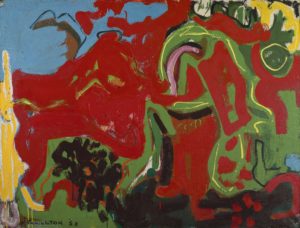
Deborah Remington Apropos or Untitled,1953. Oil paint on canvas’ 39 x 51 in. Denver Art Museum: Vance H. Kirkland Acquisition Fund, 2015.225. Courtesy of the Deborah Remington Charitable Trust for the Visual Arts.
Chanzit: Remington is such an fascinating figure. As with Jay Defeo, Sonia Gechtoff, and other West Coast women artists, Remington and was just part of the mix; there was no gender discrimination. The Six Gallery was of-the-moment, an experimental venue. Allen Ginsberg gave his first public reading of Howl there, in 1955. There was an air of exploration, and excitement—everything was very free—it was the Beat Generation. It is interesting that there was never a gender bias. Gechtoff, for example, had great success in the Bay Area in the mid 1950s, and showed in New York and in Europe. But when she moved to New York, she was shocked to see the difficult position of women in the art scene there. She never had to put up with that in San Francisco.
Ebony: What are your long-term goals for the exhibition?
Chanzit: One of my ambitions is for the exhibition to have a legacy at the Denver Art Museum. So far, we’ve managed to acquire eight paintings by women in the show for the museum’s permanent collection. Some are purchases and some are gifts. Exhibitions are important, but they’re ephemeral. It is great to have these works available to be seen by the public on a permanent basis.
David Ebony is currently a Contributing Editor of Art in America magazine. Among his books are Arne Svenson: The Neighbors (2015); Anselm Reyle: Mystic Silver (2012); Carlo Maria Mariani in the 21st Century (2011); Emily Mason (2006); Botero: Abu Ghraib (2006); Craigie Horsfield: Relation (2005); and Graham Sutherland: A Retrospective (1998). He lives and works in New York City.























